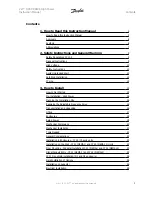
Page 52
©
2020 Sensata Technologies
Appendix B – Battery Information
Appendix B – Battery Information
B-1 Battery
Location
Periodic maintenance (i.e., checking connections, cleaning, watering) on batteries is required.
Locate the batteries in an accessible location to perform this maintenance.
Batteries must be mounted in a clean, dry, ventilated environment where they are protected
from high and low temperatures. The battery bank should be located as close to the inverter as
possible without limiting access to the inverter’s disconnects. Longer battery cable runs tend to
lose ef
fi
ciency and reduce the overall performance of an inverter.
To ensure optimum performance, a ventilated battery enclosure is recommended. Two feet of
clearance above the batteries is recommended for access to the battery terminals and removable
caps (lead acid battery types).
WARNING
: Be very careful when working around batteries, they can produce extremely
high currents if they are short-circuited. Read the important safety instructions at the
beginning of this manual and the precautions from the battery supplier before installing
the inverter and batteries.
CAUTION
: Do not mount the batteries beneath the inverter (or in the same
compartment). Batteries emit corrosive fumes which could damage the inverter’s
electronics. Never locate dedicated batteries near a fuel tank containing gasoline or
propane.
B-2 Battery
Types
Batteries are available in different sizes, amp-hour ratings, voltage and chemistries. They are also
available for starting applications (such as an automobile starting battery) and deep discharge
applications. Only the
deep cycle
types are recommended for inverter applications; using a starting
battery in an inverter (deep cycle) application will greatly shorten their useful life. Choose the
batteries best suited for the inverter installation and cost. Use only the same battery type for all
batteries in the bank. For best performance, all batteries should be from the same lot and date.
This information is usually printed on a label located on the battery.
B-3 Battery
Temperature
Battery performance of lead-acid type batteries is greatly affected by extreme temperatures. When
a lead-acid type battery is cold, its effective amp-hour capacity is reduced. When determining
the battery requirements needed for the inverter system, realize that the battery capacity will be
reduced if they will be installed in a climate where extremely cold temperatures are expected. In
this type of environment, the batteries should be located in a heated area. At the minimum, the
batteries should be installed in an insulated enclosure; which will keep the batteries warmer as
they are being charged.
The battery bank should also be protected from high temperatures, which will shorten battery
life. In high heat situations the battery room/enclosure should be ventilated to bring in cooler air
and exhaust the hotter air. The performance of the battery bank/inverter system will substantially
increase by monitoring and preventing extreme temperatures around the batteries.
B-4 Battery Bank Sizing
The size of the battery bank determines how long the inverter will power the AC loads without
recharging. The larger the battery bank, the longer the run time. Size your battery bank to the
systems AC load requirements and length of time required to run from the batteries. In general,
the battery bank should not be discharged more than 50%. Additional DC charging devices such
as solar, wind, hydro, etc., can provide longer run times by recharging the batteries in the absence
of AC shorepower or a generator.
Info:
For the MSH3012RV inverter/charger to perform optimally, a minimum battery
bank of 200 AmpHrs is recommended for moderate loads (<1000W) and greater than
400 AmpHrs for heavy loads (
≥
1000W).









































